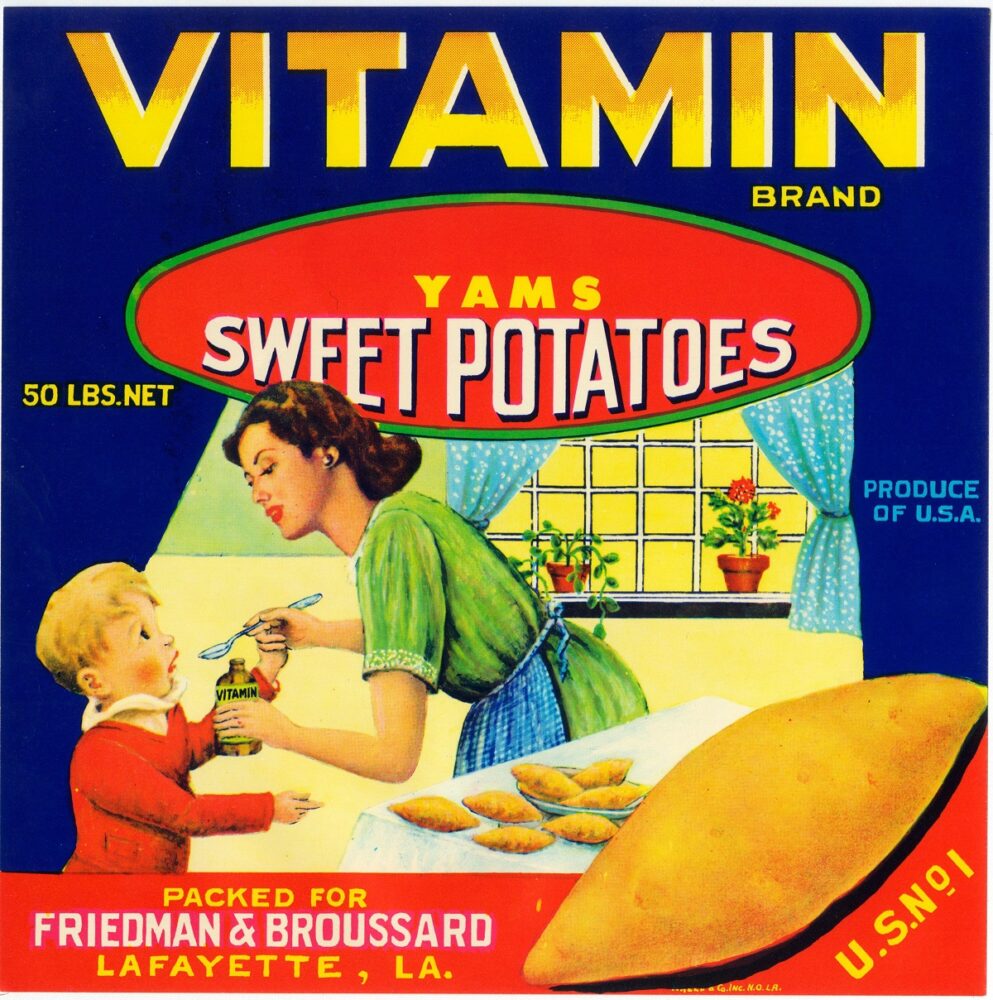I Am What I Nyam
Sweet potatoes are not yams—usually
Published: August 31, 2023
Last Updated: November 30, 2023

Chronicle / Alamy Stock Photo
A mid-century ad for Louisiana “yams.”
Yams, or as I have taken to calling them, “true yams,” are the edible tubers of perennial herbaceous vines of the Dioscoreaceae family. They have a rough dark brown skin and a dry flesh that is a bit like a white potato in texture. They are usually sold in pieces, as they can grow up to seven feet in length and weigh as much as a hundred pounds. The tubers are usually peeled, boiled, pounded, and eaten as a starchy mash; they underpin many West African sauces. The historic importance of the yam in much of western Africa is difficult to overestimate. A part of their importance comes from the traditional manner of their propagation. New yams are grown from cuttings of old yams, and so they have come to represent death and resurrection. They are celebrated in places like Ghana, where yam ceremonies are common and traditional, with the first new yam harvested often offered to the ancestors. In parts of southwestern Nigeria, the Yoruba use them as offerings in their traditional religion while the Igbo consider the yam the King of Crops.
Sweet potatoes are members of the Convolvulaceae family and are related to morning glories. They have smooth skins and moist flesh that may be orange, white, or purple and are considerably smaller than true yams. They are New World tubers that can grow in the United States. Their taste ranges from mildly sweet to very sweet, and they are served in a variety of ways that most Americans know well.
Interestingly, the linguistic confusion exists only in the United States. In other parts of the English-speaking world they are differentiated, as they are in the rest of the Western hemisphere. In the French-speaking areas, yams and sweet potatoes are igname and patate douce, respectively; in the Portuguese zones, they are inhame and batata doce; and in the Spanish-speaking world, the word for yam is ñame while the word for sweet potato is batata in Colombia, boniato in Spain, and camote in Mexico and parts of Central America.
In 1937 the word “yam” became the unofficial trademark of Louisiana sweet potatoes.
How then did these terms get conflated and confused among African Americans in the United States? For clarity, we can look at climate conditions, etymology, history, and even a Louisiana marketing effort. First: true yams are a tropical species and did not grow in the continental United States until the twentieth century. (They are now grown commercially in Florida, among other locales.) Second, their place in culture was so fundamental and profound that variants of the word yam or nyam mean “to taste” or “to eat” in several West African languages. In the Gullah language of the Geechee/Gullah Lowcountry in the United States and in Jamaican patois, the verb “to eat” is nyam—as in “food for to nyam.” It is not inconceivable then, given the cultural importance of the true yam, that early enslaved Africans gave the tuber that they had on hand the name of the tuber that they knew. The nomenclature stuck—“yam” for sweet potato—and became common currency in some parts of the country, especially among African Americans or as a southernism.
A marketing campaign for the trade group Louisiana Sweet Potatoes added to the mix-up when researcher Julian C. Miller developed a new variety of sweet potato at the Louisiana Experiment Station. This sweet potato—creamier, less stringy, with a more tender skin and a higher vitamin A content—was baptized a Louisiana yam, drawing on the familiar name that had been used by African Americans for years. In 1937 the word “yam” became the unofficial trademark of Louisiana sweet potatoes. In 2003 the Louisiana yam was designated the official state vegetable, and its cultivation provides over 20 percent of the national sweet potato crop. Today, however, no doubt in an effort to unravel the ongoing confusion, the USDA requires that the term “yam” be accompanied by the word “sweet potato” in any official description of the tuber.
The tale is convoluted—as twisty as a sweet potato vine. And, because yams are so much a part of our history, and the usage is so ingrained, the misnomer is likely to stick around for a while. So for now, just think about it when you have candied yams at Thanksgiving and end the meal with sweet potato pie—both prepared from the same tuber.
Jessica B. Harris is the author, editor, or translator of eighteen books, including twelve cookbooks documenting the foodways of the African Diaspora. In March of 2020, she became a James Beard Lifetime Achievement awardee.
